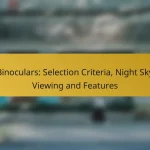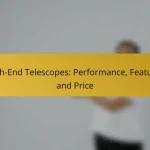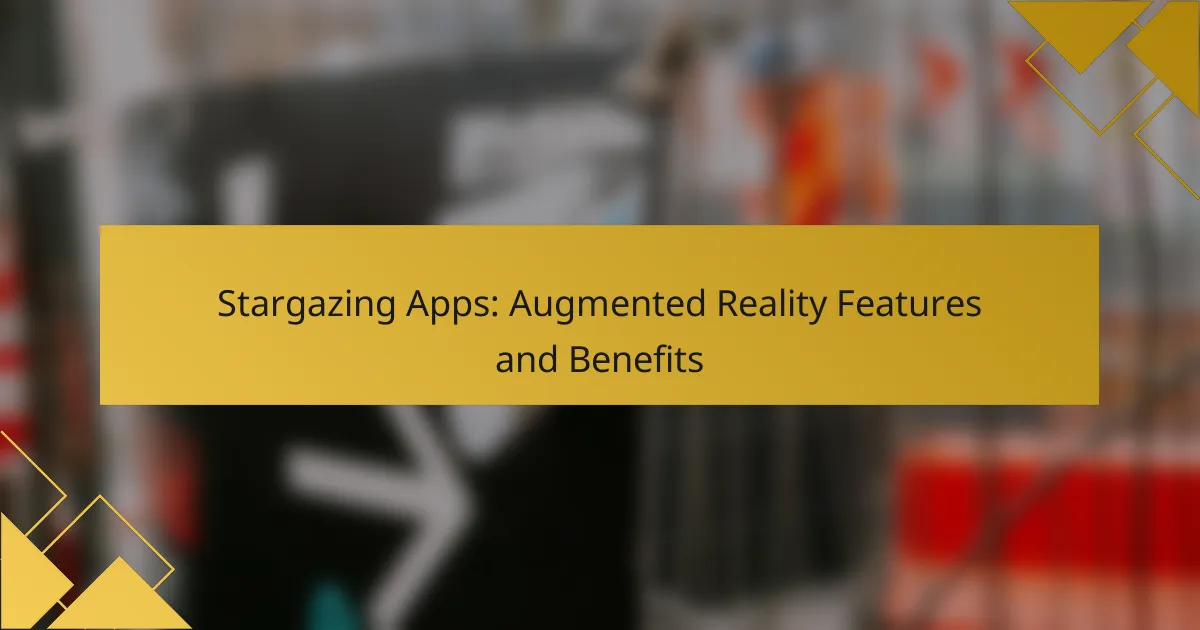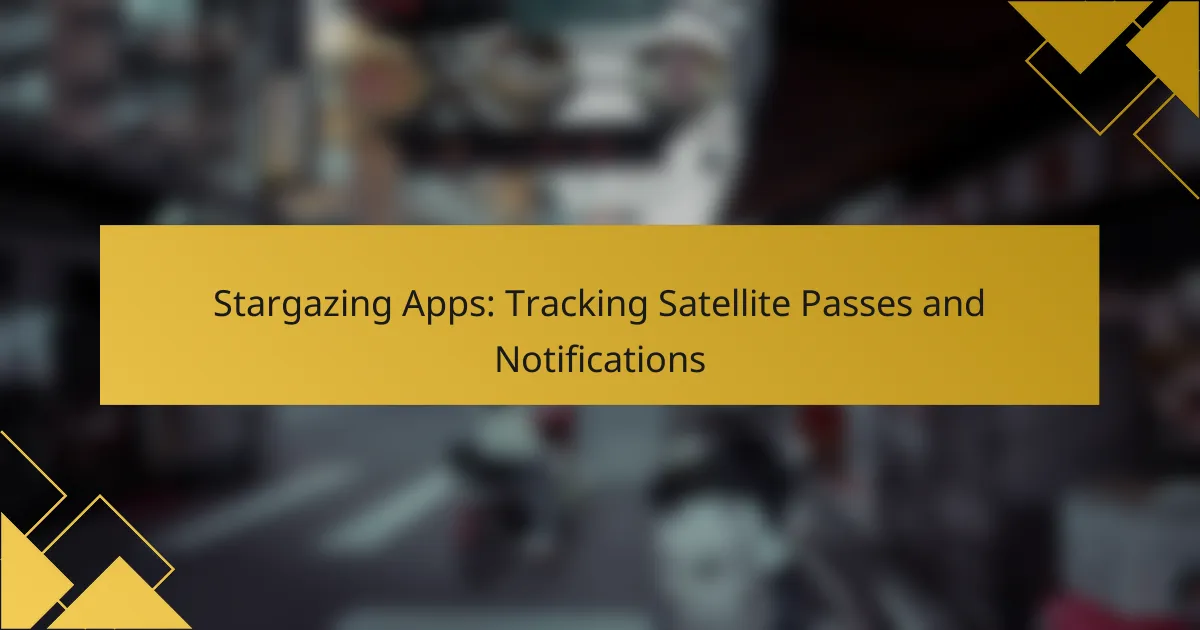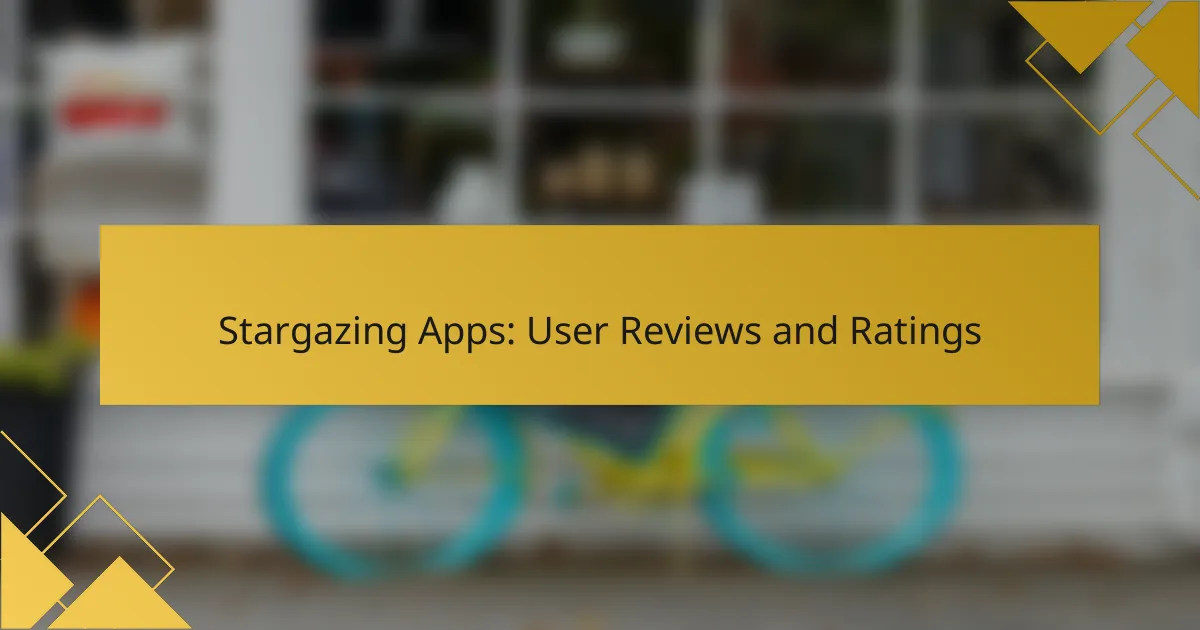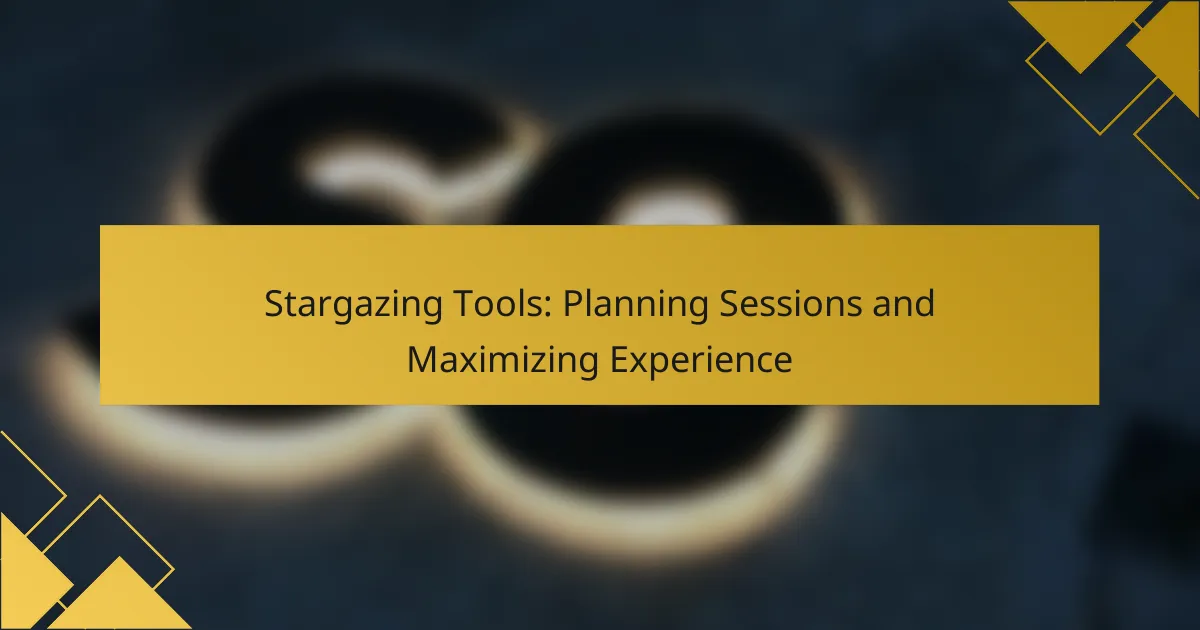When it comes to stargazing apps, users can choose between free and paid options, each catering to different needs and preferences. Free apps provide essential features for casual stargazers, while paid versions offer advanced tools and an ad-free experience, making them ideal for serious astronomy enthusiasts. Understanding the strengths of each type can help users decide which option best suits their stargazing goals.
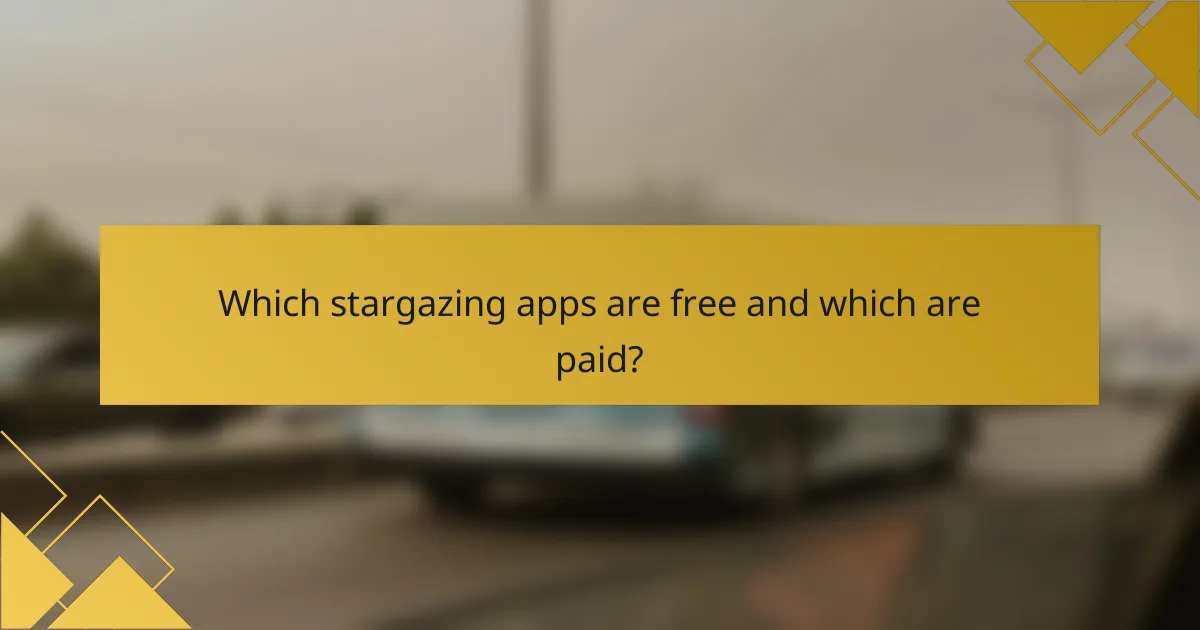
Which stargazing apps are free and which are paid?
Stargazing apps can be categorized into free and paid options, each offering unique features. Free apps typically provide basic functionalities, while paid apps often include advanced tools and content for serious astronomy enthusiasts.
Stellarium (Free)
Stellarium is a free, open-source planetarium software that allows users to explore the night sky in real-time. It features a realistic 3D rendering of the universe, showing stars, planets, and constellations as they appear from any location on Earth.
This app is particularly useful for beginners, as it offers a user-friendly interface and extensive educational resources. Users can customize their experience by adjusting the time and location to see how the sky changes throughout the night.
SkySafari 6 (Paid)
SkySafari 6 is a comprehensive paid stargazing app that offers a wealth of features for serious astronomers. It includes detailed star maps, telescope control, and a vast database of celestial objects, making it suitable for both amateur and professional use.
With a one-time purchase, users gain access to extensive content, including detailed descriptions and images of stars and galaxies. The app also allows for offline access, which is beneficial in areas with limited internet connectivity.
Star Walk 2 (Free)
Star Walk 2 is a free app that provides an interactive stargazing experience with augmented reality features. Users can point their device at the sky to identify stars, planets, and constellations in real-time, making it easy to learn about celestial objects.
This app is ideal for casual stargazers and families, as it includes engaging animations and educational content. While the free version offers a solid experience, some advanced features may require in-app purchases.
SkyView (Free)
SkyView is another free stargazing app that allows users to explore the night sky using their smartphone’s camera. By simply pointing the device at the sky, users can identify celestial bodies and learn about their characteristics.
This app is user-friendly and suitable for all ages, making it a great choice for beginners. It also includes a night mode to preserve night vision and enhance the stargazing experience.
Star Chart (Paid)
Star Chart is a paid app that offers a detailed and interactive view of the night sky. It features a rich database of stars, planets, and other celestial objects, along with augmented reality capabilities for an immersive experience.
With a one-time purchase, users can access advanced features such as time travel to see how the sky changes over days, months, or years. This app is particularly beneficial for those looking to deepen their understanding of astronomy and celestial movements.

What are the benefits of free stargazing apps?
Free stargazing apps offer users the chance to explore the night sky without any financial commitment. These applications typically provide essential features that can enhance the stargazing experience, making them accessible to a wide audience.
No cost for users
The most significant advantage of free stargazing apps is that they come at no cost, allowing anyone to download and use them without worrying about subscription fees or one-time payments. This accessibility encourages more people to engage with astronomy and explore celestial objects.
While many free apps are ad-supported, the presence of advertisements usually does not interfere significantly with the user experience. Users can enjoy stargazing without financial barriers, making it easier to share the experience with friends and family.
Basic features for casual stargazers
Free stargazing apps typically include fundamental features such as star maps, constellation identification, and basic information about celestial events. These tools are sufficient for casual stargazers who want to enjoy the night sky without delving into advanced astronomy.
For example, many free apps allow users to point their smartphones at the sky to identify stars and planets in real-time. This augmented reality feature can enhance the learning experience and spark interest in deeper astronomical studies.
However, users should be aware that while free apps provide essential functionalities, they may lack advanced features like detailed star catalogs, high-resolution imagery, or personalized recommendations found in paid versions. Casual stargazers can benefit from these basic tools without needing to invest financially.
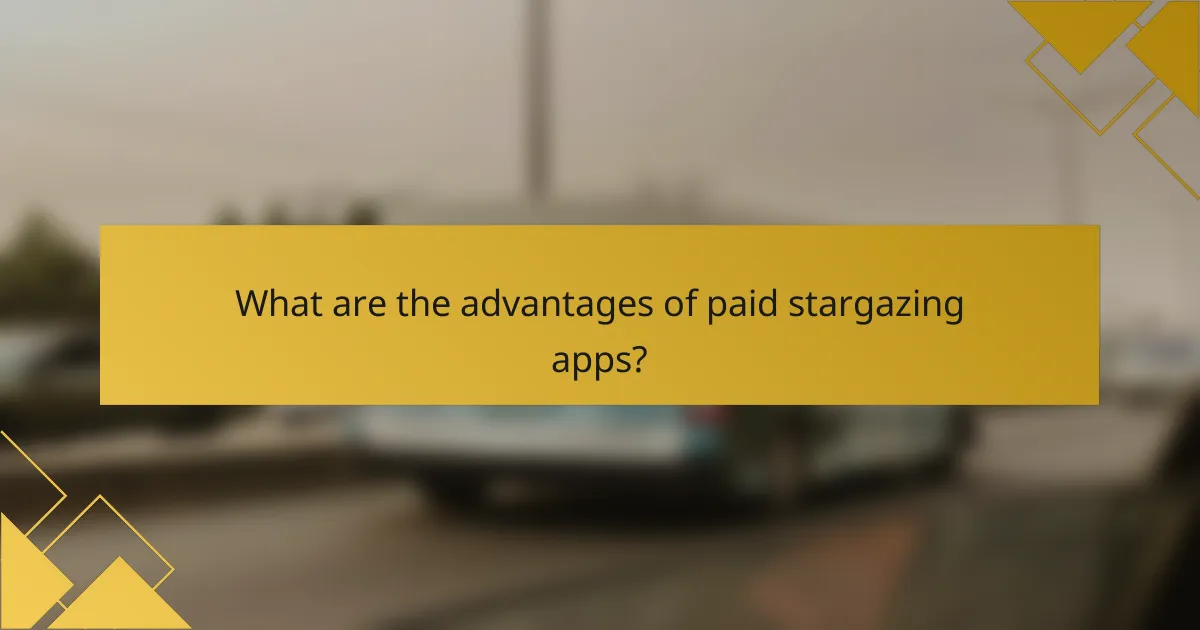
What are the advantages of paid stargazing apps?
Paid stargazing apps offer several advantages over free versions, including enhanced features, an ad-free experience, and ongoing support. These benefits can significantly improve the overall stargazing experience, particularly for those who are serious about astronomy.
Advanced features for serious astronomers
Paid stargazing apps typically include advanced features that cater to serious astronomers. These may consist of detailed star maps, advanced tracking capabilities, and tools for astrophotography. Users can access high-resolution images and data on celestial events, which are often not available in free apps.
For example, some paid apps provide augmented reality (AR) overlays that help users identify constellations and celestial objects in real-time. These features can enhance learning and engagement for both amateur and professional astronomers.
Ad-free experience
One significant advantage of paid stargazing apps is the absence of advertisements. Free apps often rely on ads for revenue, which can interrupt the user experience and detract from stargazing. A paid app allows users to focus solely on the night sky without distractions.
This uninterrupted experience can be particularly valuable during stargazing sessions, where concentration is key to enjoying the beauty of the cosmos. Users can immerse themselves in the experience without the annoyance of pop-ups or banner ads.
Regular updates and support
Paid stargazing apps generally offer regular updates that enhance functionality and introduce new features. Developers are more likely to invest in the continuous improvement of paid apps, ensuring they remain relevant and up-to-date with the latest astronomical discoveries.
Additionally, paid apps often come with customer support options, allowing users to get assistance with any issues they may encounter. This level of support can be crucial for users who rely on the app for educational or professional purposes.

When should you choose a free stargazing app?
Free stargazing apps are ideal when you want to explore the night sky without financial commitment. They provide basic features that are often sufficient for casual users and those just starting their astronomical journey.
Casual stargazing
If you enjoy occasional stargazing, a free app can meet your needs effectively. These apps typically offer essential functionalities like star identification, constellation maps, and basic celestial event notifications. For example, apps like SkyView Lite or Star Walk 2 Lite allow users to point their devices at the sky and easily identify stars and planets.
For casual stargazers, the simplicity of free apps can enhance the experience without overwhelming them with advanced features. They are perfect for family outings or spontaneous nights under the stars.
Budget constraints
When financial limitations are a concern, free stargazing apps provide a no-cost alternative to premium options. Many of these apps offer enough features to satisfy basic astronomy enthusiasts without requiring any investment. This is particularly beneficial for students or hobbyists who may not want to spend money on subscriptions or one-time purchases.
However, it’s important to recognize that free apps may have limitations, such as ads or fewer features compared to their paid counterparts. Users should evaluate their needs and consider whether the basic functionality is sufficient for their stargazing activities.
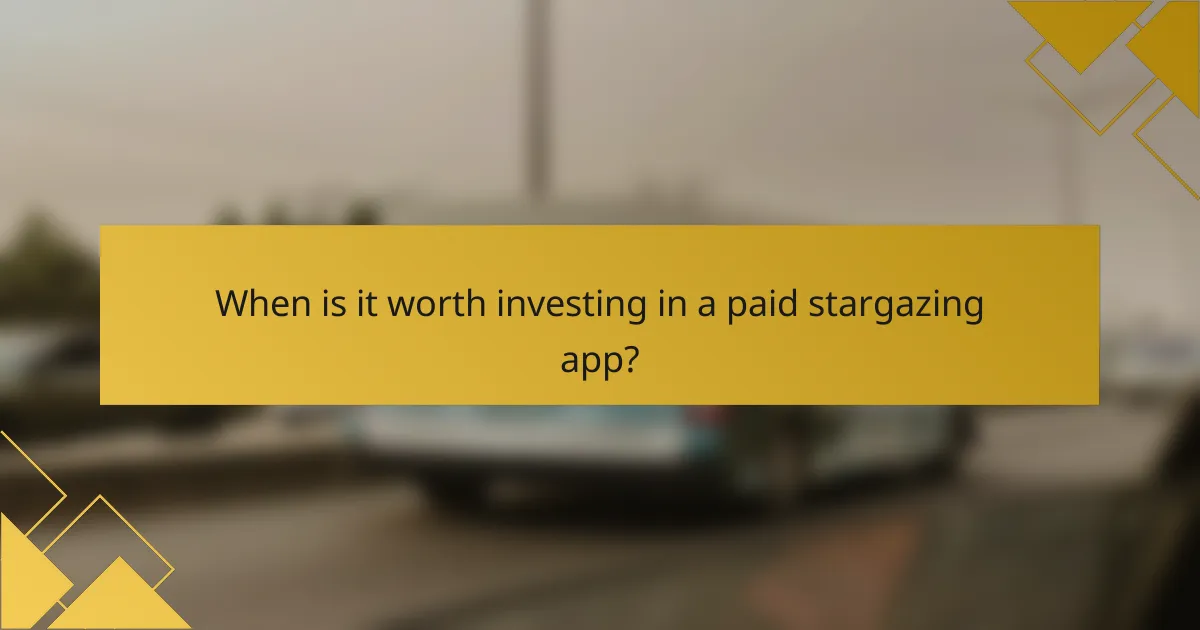
When is it worth investing in a paid stargazing app?
Investing in a paid stargazing app is worthwhile when you seek enhanced features, regular usage, and a more comprehensive experience. Paid apps often provide advanced tools, detailed star maps, and personalized content that free versions may lack.
Frequent use for astronomy enthusiasts
If you frequently engage in stargazing, a paid app can significantly enhance your experience. Regular users benefit from features like offline access, detailed celestial events, and personalized notifications, which can deepen your understanding of astronomy.
For enthusiasts who stargaze multiple times a month, the investment in a paid app can pay off quickly. Many paid apps offer subscription models, typically ranging from $10 to $30 per year, making them accessible for dedicated users.
Need for advanced tools and features
Paid stargazing apps often include advanced tools such as augmented reality, detailed satellite tracking, and in-depth educational content. These features can help users identify celestial objects more accurately and provide insights into their movements and characteristics.
Consider a paid app if you require specific functionalities like astrophotography tools or integration with telescopes. These advanced features can elevate your stargazing experience, making it more interactive and informative.
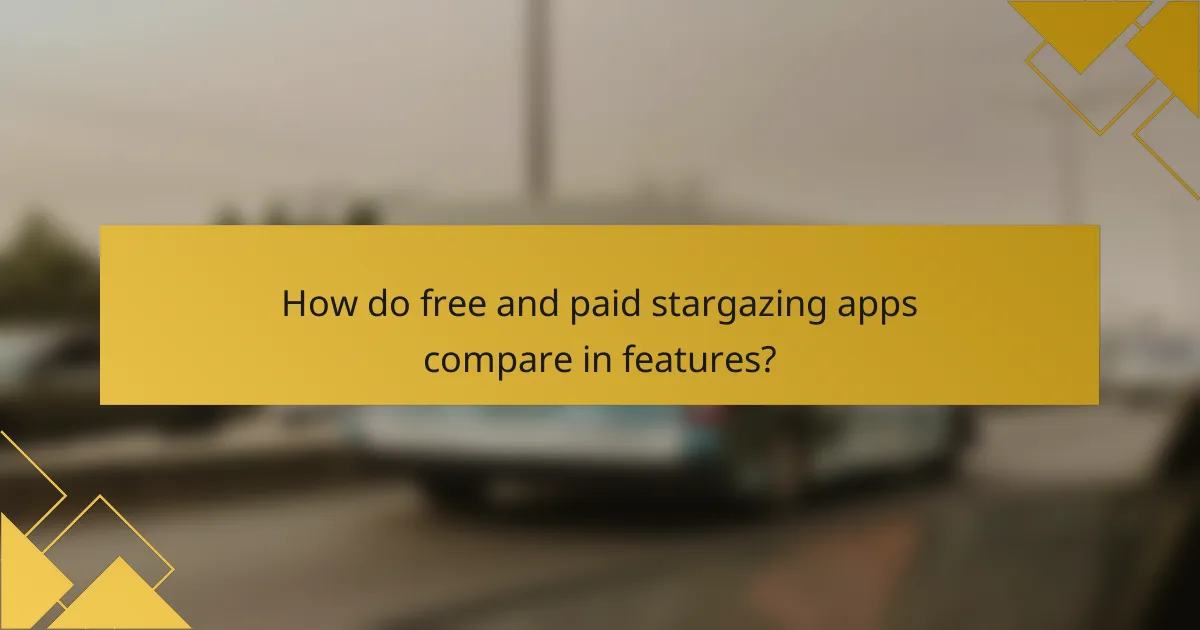
How do free and paid stargazing apps compare in features?
Free and paid stargazing apps differ significantly in features, usability, and content depth. Free apps often provide basic functionalities, while paid versions typically offer advanced tools, enhanced user experiences, and additional content.
Features of Free Stargazing Apps
Free stargazing apps generally include essential features such as star maps, constellation identification, and basic information about celestial objects. They are suitable for casual stargazers who want to explore the night sky without any financial commitment.
However, these apps may have limitations like ads, reduced accuracy, and fewer updates. Users might find that the information is not as comprehensive, which can hinder deeper exploration of astronomy.
Features of Paid Stargazing Apps
Paid stargazing apps offer a richer experience with advanced features such as augmented reality, detailed star charts, and extensive databases of celestial objects. Many paid apps also include offline access, personalized notifications for celestial events, and educational content.
Investing in a paid app can enhance your stargazing experience, especially if you are serious about astronomy or want to learn more. The cost typically ranges from a few dollars to around 30 USD, depending on the app’s capabilities.
When to Use Free vs. Paid Stargazing Apps
Free apps are ideal for beginners or casual users who want to dip their toes into stargazing. They are a great starting point for those who are unsure about their interest level or who stargaze infrequently.
On the other hand, if you are a dedicated astronomy enthusiast or plan to engage in stargazing regularly, a paid app is worth considering. The investment can provide you with the tools and information needed for a more fulfilling experience, especially during events like meteor showers or eclipses.
